5 Observations From My Tropical Garden - Ometepe, Nicaragua
With all systems, it is integral to observe before acting. Equally as important, is the observation you do in reflection, once you have completed a few steps into the action plan.
When I was on Ometepe, Nicaragua, I was building a restaurant garden for Little Morgan's Hostel at the beginning of rainy season, so it was all a bit of a busy kafuffle to get things ready before the big rains came. Despite this, I made time to assess the steps I'd taken and to understand the lessons I was learning in order to remedy my behaviour as I went. That reflective period taught me a few hard lessons:
1. Tropical rain is hard to deal with
When it comes to rainwater harvesting, the tropics have their own set of complications. While half the year it's throwing rain out of the sky like a clown with a bucket, the other half is dry as a bone. While obviously we want harvest as much rainwater as we can in order to keep the plants satisfied in dry season, when that rain comes down in rainy season, it comes so thick and fast that the beds become saturated.
As some work had been done in one area before I came, I was able to actually compare the different methods used. The guys here had already transplanted tomato plants into terraces when I arrived, without preparing the soil. This means that when it rains, while the terraces help to halt the water, once the bed becomes full, it overflows and the soil starts the erode down the beds. However, I used sheet mulching with rice husks and weeds on the new beds I built. This not only suppresses the weeds, but it holds the water, absorbing it into the rice husks.
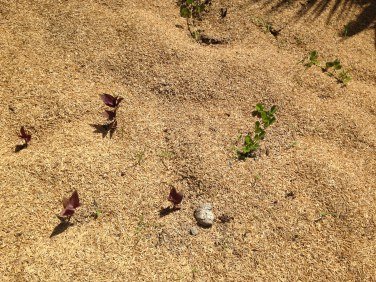
I have noticed a few things with this method. The soil isn't eroding and the weeds are suppressed which means the seedlings seem to be sprouting up at record rate. With the tomatoes, you can see that some areas are more eroded than others, and in those eroded areas, the tomatoes are not growing so well or dying off; especially at the top of the bed.
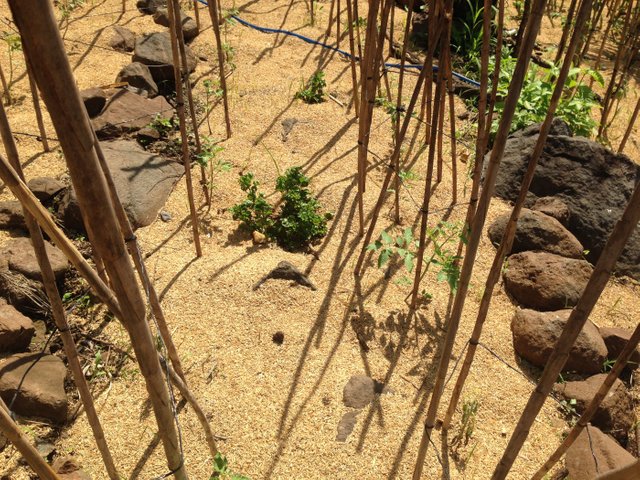
I spent my time trying to combat this by laying rice husks down. It wasn't impossible but it was tedious to weave in and out of the plants. Rather than laying green mulch on these areas, I laid edible cover crops in between; some give nitrogen to the soil, some shade, some were simply weed suppressants, but all of them help to hold and harvest the water.
2. The insects love anything non-native
When I first arrived at Little Morgan's, I was fortunate enough to bump into Scott, one of the teachers at Rancho Mastatal. It was my first day here and his advice was invaluable. He told me that it's hard to grow food here because the insects are ferocious. I was a little confused at first, because everyone has to eat, but then I realised he was referring to the kinds of vegetables we can easily grow in the UK.
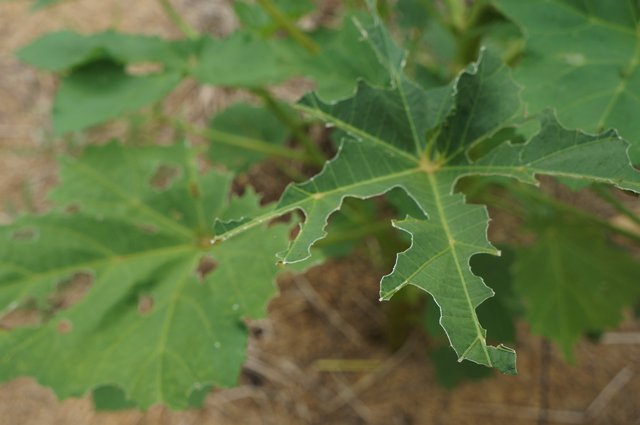
Okra isn't native and had a hard time starting out, especially planted next to non-native cucumbers
I observed the garden to work out where the insects like to flock to and where they stay away. It became apparent very quickly that native plants were far more hardy to the attacks of the insects. I started to chat to the local guys to find out more about edible weeds and indigenous plants. They pointed me toward a wild bean, certain squashes, indian lettuce, wandering jew, cucaracha, katuk, chaya, and other such plants. I've been planting these in the garden and so far, they seem to be much more hardy. While the insects are slowly mauling the tomatoes, they tend to steer clear from these more native species.
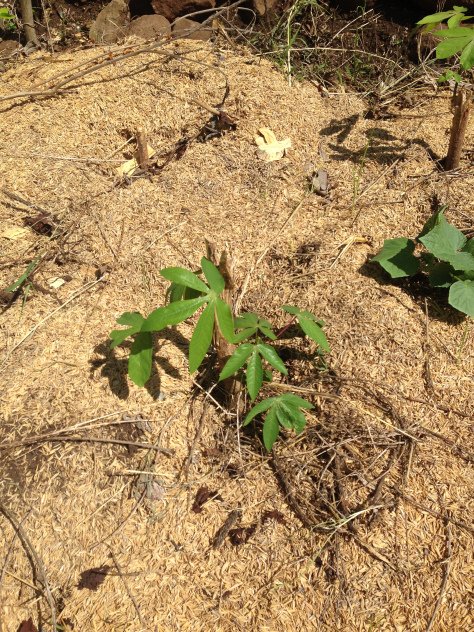
Native yucca
The shows that part of permaculture is to think about how to adapt to your surroundings. While it's great to have an iceberg lettuce for a solid BLT, using native edible leaves as lettuce is going to have a much higher success rate.
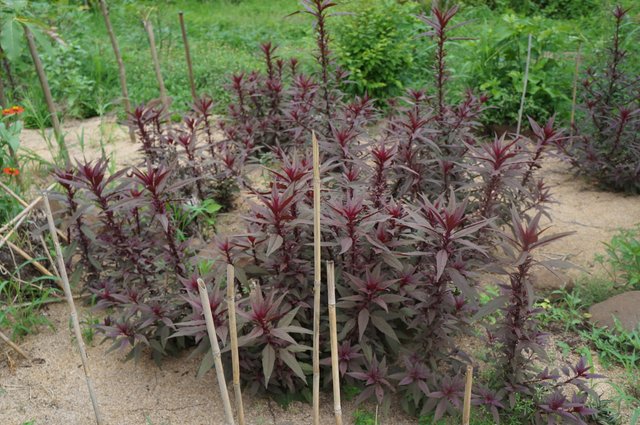
Purple Amaranth of Cucuracha as the locals called it - We used this in the BLT!
3. The jungle will always try to take the land back
I noticed that I needed creative ways to keep the jungle back. Whether that's using thick mulch or cover crops, it is important to suppress the weeds in order to intensively grow enough food. While I have of course worked in other gardens with weeds growing, the jungle is a different ballgame. If I weeded a bed, left the soil bare, and came back that evening, there would be weeds again.
I experimented with all different ways. I planted lemongrass at the edges to use their dense root system to keep back weeds. I also planted squashes all around the patches, as their large leaves help to keep the weeds back using shade. Varying cover crops helped me to work out which plants work best with with vegetables to keep the weeds back without affecting the growth of the veggies; the variety also increases the biodiversity. I used ginger and turmeric at the edges and yard beans along the fences. I'll be honest, all these methods worked in some way, with the lemongrass and beans probably working the best to real force the jungle back.
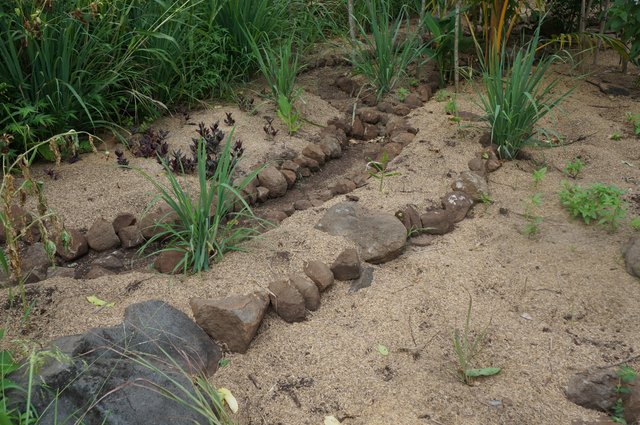
4. A decent plant nursery is essential
When I first got there, the garden guys were using plastic crates filled with soil as a plant nursery. There are a few issues with this that prevent seedling sprouting.
Firstly, the rain is so heavy that it left the box saturating and becoming swampy. There's no places for it to drain. Equally, they used the same soil from the ground, without mixing in sand, making it difficult for things to root easily. Secondly, the boxes aren't shaded and the blistering tropical sunshine leads to seedlings withering; they need some kind of shade.
I designed a water-harvesting plant nursery. You can see the design here.
I never made it. Probably because I was busy, probably because I was lazy, probably because I was scared I couldn't and it would look tragic. Probably all of the above. However, it is something that I will definitely be trying out next time.
5. Terracing creates a series of microenvironments
I'd never worked so closely with terraces before and seeing them everyday enabled me to understand their power. With all gardens, different areas should be treated differently due to their ranging features; some areas have more shade, water, wind, light.
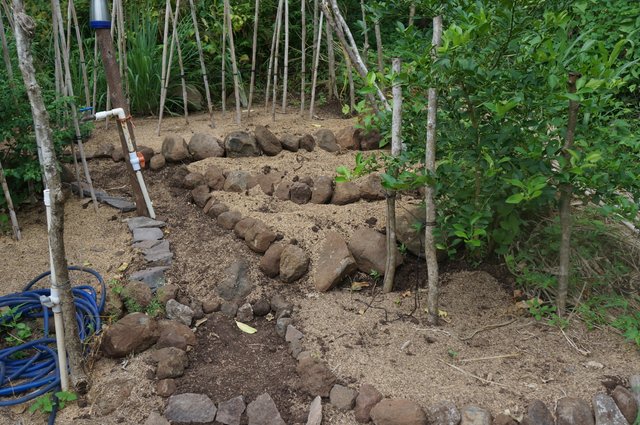
Spoon-dug terraces - tools were in shortage
However, interestingly, by creating terraces, we created several different areas to work with. The top of the terracing tended to get more flooded than the bottom, which didn't appear to make logical sense, but it did. This means that plants that like wet feet, tended to be doing better up there; such as lemongrass. With this observation, I planted yucca at the bottom (north). Planting it here was a conscious decision as its northern location means it won't shade out the garden, but it is also quite drought hardy, so it would be fine with less water.
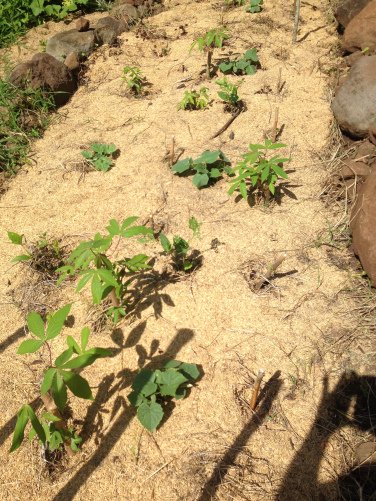
Yucca, loofas, beans, cucumbers - The cucumbers were a mistake
I planted varying crops all over the place. As they grew (or didn't), I was able to see what did well together where and replicate this in similar areas.
This planting and revision enabled me to learn from what I was dong and to re-evaluate the system to increase its productivity through pattern recognition. It was frightfully interesting!
Tanks for sharing your observations. We live in southern Mo and have have noticed similar things. The volunteer seedlings and natives outpace our starts by a LOT, and the "jungle" ( or mixed hardwood forest) seeks to take back the zones we've cleared. We've blessed with purslane and lambs quarters that show up wherever the soil is left bare. Like you plenty of sheet mulch and OM makes the whole system run more smoothly. Happy to see you representing Permcautlure on steemit!
Gotta spread that permie love! When I was in Nicaragua I kept a little zone 5 and it really helped me to mimic the same ratio patterns of nitrogen fixers to dynamic accumulators etc and that kept stuff back :)